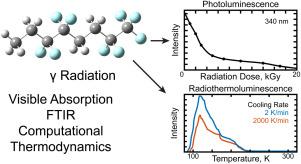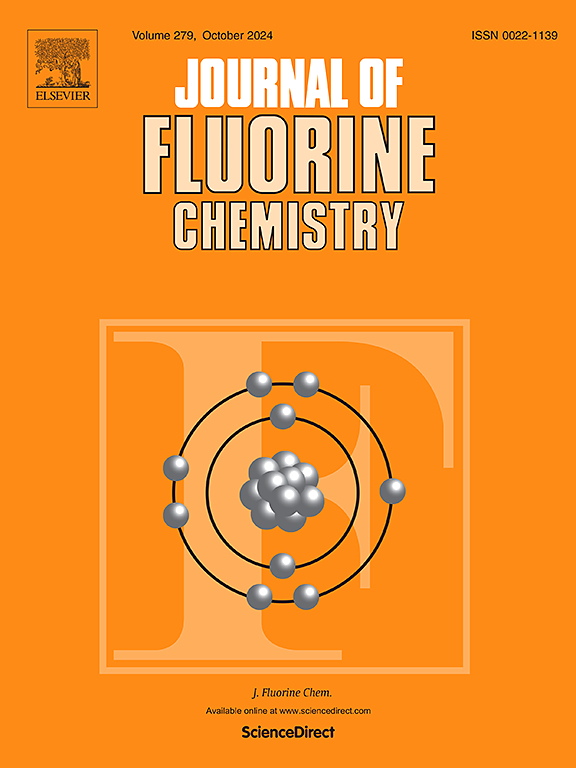Post-Irradiation photoluminescence and thermoluminescence of the ethylene-tetrafluoroethylene copolymer
IF 1.9
4区 化学
Q3 CHEMISTRY, INORGANIC & NUCLEAR
引用次数: 0
Abstract
The effect of γ-irradiation on the post-irradiation thermoluminescent and photoluminescent properties of an industrial ethylene-tetrafluoroethylene (ETFE) copolymer was investigated. The radiothermoluminescence (RTL) curve in the temperature range of 77 to 400 K exhibits three maxima: the most intense peak occurs at 116 K, while two additional maxima appear as shoulders at 168 K and 210 K. These maxima result from the formation and subsequent quenching of electronically excited states caused by the recombination of charge carriers accumulated during γ-irradiation of the copolymer at 77 K. Photoluminescence arises from the radiative recombination of excitons formed in the copolymer upon photoexcitation with a xenon lamp at 300 K. The photoluminescence maximum occurs at 340 nm, and its intensity decreases as the γ-irradiation dose increases. Structural defects and macromolecular cross-linking induced by γ-irradiation act as centers of nonradiative exciton recombination, thereby reducing the intensity of the post-irradiation luminescence of the copolymer. Electronic structure predictions of the degradation thermodynamics indicate that polymer backbone degradation through either loss of small unsaturated molecules or carbenes is unfavorable at room temperature but is possible under γ-irradiation conditions.

乙烯-四氟乙烯共聚物的辐照后光致发光和热致发光
研究了γ辐照对工业乙烯-四氟乙烯(ETFE)共聚物辐照后热致发光和光致发光性能的影响。辐射热释光(RTL)曲线在77 ~ 400 K温度范围内表现出3个峰值:116 K时出现最强烈的峰值,168 K和210 K时出现另外两个峰值。这些最大值是由共聚物在77 K γ辐照期间积累的载流子重组引起的电子激发态的形成和随后的猝灭造成的。在300 K氙灯的光激发下,共聚物中形成的激子的辐射重组产生了光致发光。光致发光最大值出现在340 nm处,其强度随γ辐照剂量的增加而减小。γ辐照引起的结构缺陷和大分子交联作为非辐射激子重组的中心,从而降低了共聚物的辐照后发光强度。降解热力学的电子结构预测表明,在室温下,通过小不饱和分子或碳烯的损失来降解聚合物主链是不利的,但在γ辐照条件下是可能的。
本文章由计算机程序翻译,如有差异,请以英文原文为准。
求助全文
约1分钟内获得全文
求助全文
来源期刊

Journal of Fluorine Chemistry
化学-无机化学与核化学
CiteScore
3.80
自引率
10.50%
发文量
99
审稿时长
33 days
期刊介绍:
The Journal of Fluorine Chemistry contains reviews, original papers and short communications. The journal covers all aspects of pure and applied research on the chemistry as well as on the applications of fluorine, and of compounds or materials where fluorine exercises significant effects. This can include all chemistry research areas (inorganic, organic, organometallic, macromolecular and physical chemistry) but also includes papers on biological/biochemical related aspects of Fluorine chemistry as well as medicinal, agrochemical and pharmacological research. The Journal of Fluorine Chemistry also publishes environmental and industrial papers dealing with aspects of Fluorine chemistry on energy and material sciences. Preparative and physico-chemical investigations as well as theoretical, structural and mechanistic aspects are covered. The Journal, however, does not accept work of purely routine nature.
For reviews and special issues on particular topics of fluorine chemistry or from selected symposia, please contact the Regional Editors for further details.
 求助内容:
求助内容: 应助结果提醒方式:
应助结果提醒方式:


